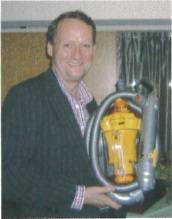The little vacuum cleaner that could
by Jonathon Walsh
Russian author and historian Aleksandr Solzhenitsyn once quoted Stalin as saying that the dictator had decided to live to be 100 or die in the attempt. The mental fortitude behind that bold ambition very accurately sums up how Gordon Thorn, Chairman of vacuum cleaner manufacturer Dyson Japan feels about hitting his ambitious sales target of six million units in the Japanese market. “It’s where we want to go and if we don’t get their entirely, we won’t be too disappointed, but there’s nothing like being ambitious,” he said at EA Tokyo’s Sep. 6 seminar where he spoke about establishing a brand and competing in the fiercely competitive Japanese floor care market.
Dyson set up its Japanese operations in 1998, and sales in 2005 are expected to be around 200,000 units.
Functionality over form
Emphasizing functionality over form, company founder James Dyson outlined a key concept for producing great products: “Design is not about the way a product looks, but the way it works.” The end result of this simple but effective approach has blazed the way for Dyson vacuum cleaners to become the best-selling machines in Europe, the U.S., and Australia. In Japan, the company’s machines are sold in some 1,800 stores, and while being a relatively new entrant in the local vacuum cleaner market, the Japan subsidiary of British vacuum cleaner manufacturer Dyson Limited now controls just over ten percent of the market.
A Japanese company paved the path for development
How did Dyson get off the ground? Thorn explained that it was never Dyson’s intention to be a vacuum cleaner designer. “He was vacuuming one day and found the vacuum cleaner didn’t work. Opening it up, he saw the bag was full, replaced it and it started working okay, but after doing a couple of rooms, he noticed suction had dropped off again. He took the bag out and saw the inside was coated with dust. His simple thought but massive conceptual leap was, if I can make a vacuum cleaner without a bag, I can make a vacuum cleaner that won’t lose suction.”‘ After building more than five thousand prototypes of the Dual Cyclone™, he eventually developed a design that met specifications, and most importantly, worked.
Having surmounted the design challenge, Dyson then faced another — selling his idea. After having his revolutionary design repeatedly turned down, Dyson eventually found a Japanese company that expressed interest in his product. He designed and built his first cyclonic vacuum cleaner. Using income from the Japanese license, Dyson decided to manufacture a new model under his own name in Britain. The result was launched in 1993, and the rest, as they say, is history.
Only 30 months out from launch, Dyson became the best seller in the market. The company now has more than 50 percent of the U.K. vacuum cleaner market and has been taking a steadily increasing share of the higher end segment.
Revolutionizing the market
While almost all other vacuum cleaners use bags to capture dust, one of the key points of difference is that Dyson machines do not. And because there is no bag, there is nothing to block airflow, allowing Dyson cleaners to maintain 100 percent suction, 100 percent of the time.
So, what’s happening in the Japanese vacuum cleaner market?
“Dyson started selling in Japan in 1999, and in a good year, we were selling about 20,000 units,” Thorn explained. “The problem is there are about 5.5 million vacuum cleaners sold in Japan every year, so we weren’t really making much of an impact on the market. It didn’t take long for the Japanese competition to design cyclonic cleaners. However, since 2003 the cyclonic category in Japan has begun to shrink because they don’t perform.”
However, Dyson is still revolutionizing the market. The only price segment that has grown in value and volume is Dyson’s territory — the premium price end of the market.
After surveying consumers, Dyson found the key problems experienced by consumers were dirty and smelly exhaust air, weak suction power, the cleaner losing suction, and the need to buy and replace bags.
To meet these design challenges, Dyson have come up with the DC12.
An unusual product requires unusual methods
So how is Dyson marketing its machines? The company follows simple principles:
- If the product is right, everything else is (relatively!) easy — if the product isn’t right, people are not going to buy it.
- Keep it simple — make it easy for Dyson people to execute and for consumers to understand.
- Focus on technology and benefits — Dyson do not talk about the design and the colors. Instead, they focus on the technology and the benefits it provides to the consumer.
- Let the consumer decide — if Dyson get the top three points reasonably right, they believe consumers will choose their products.
And in-store? Venture into any large Japanese electrical appliance store and your senses are likely to be assaulted by a maelstrom of sound and color. How does Dyson make its vacuum cleaners stand out in these noisy, bustling environments? The company’s marketing strategy is — keep it simple.
Along with training and educating store staff, Dyson ensures product displays are relatively clear of clutter and signs. “We go for a nice simple black background against which our products stand out — we try to keep it looking as simple as possible. By doing so, we ensure that our products are visible. We have a very simple product brochure and don’t fill it with masses of text and pictures of singing housewives.”
Thorn said Dyson expects to sell close to 200,000 units this year out of 6 million. “The market is going to grow from 5.8 million in 2004 to 6 million in 2005.”
For more information please visit www.dyson.co.jp or www.dyson.com.









